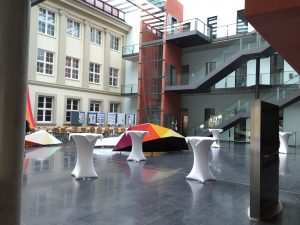Würzburg and Franconia are most commonly known for beautiful castles and superb wine. However, the University of Würzburg is better known for the 14 Nobel Laureates who have researched and taught there, including Harald zur Hausen, who received the Nobel Prize for Medicine in 2008 for his discovery that human papillomaviruses can cause cervical cancer. Prof zur Hausen spent his post-doc years from 1969 to 1972 at the Institute for Virology and Immunobiology, and it was this institute which hosted the first SphingoFOR 2123 workshop on “Sphingolipids in infection control and beyond” on June 25th-26th 2015 at the venue of the Institute for Molecular Infection Biology (IMIB) and Research Center for Infectious Diseases (ZINF) in Würzburg.

Würzburg (photo: S. Schonauer)
Within SphingoFOR, international scientists gathered to discuss sphingolipid dynamics in infection control. As workshop organiser Prof Sibylle Schneider-Schaulies explained, “Sphingolipids and their ceramide metabolites play a key role in the dynamics of activated membrane microdomains. Because immune responses can also be regulated at the level of sphingolipid dynamics, this pathway most likely controls decisive elements in the pathogenesis of infectious diseases, where pathogen uptake, spread, and dissemination are counteracted by host cell innate and adaptive immune responses.” Founded in 2013 and supported by the DFG, SphingoFOR 2123 aims at combining highly advanced and novel approaches to study adaptive and innate immunity, pathogen adhesion and invasion, and the cell autonomous immune defence.
“My lab is interested in viruses, especially the measles virus and how it modulates the immune system over time. We have focused especially on T cells which, once they see measles virus, don’t do their job anymore”, Prof Schneider-Schaulies added. Her group found out that one major way how these viruses outsmart T cells is that they modulate lipids within the T cell membrane. “One should remember that sphingolipids are a major component of the cell membrane which doesn’t only function as a barrier but is also a very active platform surrounding the cell where lots of molecules are sorted. It is also involved in regulatory pathways. This is why sphingolipids are a crucial topic and need to be studied.” Membranes, and, therefore, also sphingolipids, are very important in immune cells as they have to respond quickly to challenges. Viruses also need to move quickly when entering or leaving a cell in order to not be trapped. “The interaction between sphingolipids and pathogens is especially important and I think we’re collaborating at an important intersection of basic biology and infection research. I think we can learn a lot from each other and this is exactly what this meeting was meant for.”

The venue’s architecture was an interesting mix of old and new (photo: S. Schonauer)
The meeting itself took place at a beautifully renovated venue which impressively combined old and modern architecture. Well-known speakers from different countries gave 30 minute talks in sessions dealing with sphingolipids in pathogen adhesion, entry, and transmission, sphingolipids in immune regulation, and, finally, lipid signalling and lipid/protein interactions. One of the topics that always recurred during the two-day meeting were approaches to detect and visualise lipids. Even though technology has come pretty far and microscopes are able to visualise structures beyond the diffraction limit, effectively visualising lipids remains a major issue. Thanks to the discovery of green fluorescent protein and its relatives, proteins genetically modified to produce fluorescently tagged versions can easily be detected and tracked when exposed to light of a certain wavelength. Furthermore, specific antibodies are available for many proteins making lab life and immunocytochemistry much easier. Lipids, on the other hand, are molecules that are constantly metabolised in the cell and there is no way of simply heterologously expressing fluorescent analogues. The cell synthesises all lipid building blocks from scratch or recycles them via complicated salvage pathways. Therefore, scientists have had to develop different protocols by which cells are fed with artificial, fluorophore-tagged lipid derivatives. Lipids modified with dyes like NBD (7-Nitrobenz-2-Oxa-1,3-Diazol-4-yl) and bodipy (boron-dipyrromethene) are commonly used. These modifications, though relatively small, may still perturb the physiological composition of the membranes they are inserted to. This caveat might be overcome by establishing even smaller modifications (e. g. terminal alkyne or azide groups) that, after the sphingolipids got incorporated into the membrane, allow for clicking to certain dyes. Additionally, during the last couple of years, antibodies have been developed that recognise lipids. Here, lipids, which per se do not evoke an immune response, are synthetically coupled to certain proteins, injected into animals, e. g. rabbits and then serum samples are collected and screened for specific antibodies against the lipid of choice via ELISA. Analogous to antibodies directed against proteins, blood is then isolated from animals with a high antibody titre and the serum can then be used to (hopefully) specifically detect a certain lipid in immunohistochemistry or immunocytochemistry. The “hopefully”-part represents the crux here: proving the specificity of an antibody against an epitope that mostly sits inside a membrane and therefore is not perfectly accessible is technically challenging. During the meeting many speakers presented data that were generated using specific anti-ceramide or anti-glucosylceramide antibodies (lipids that belong to the glycosphingolipid family and are synthesised downstream of sphingosine). The results and protocols behind those images were examined extensively to exclude the possibility that the findings were artefacts.
Overall, the first SphingoFOR meeting stood out for its lively discussions and the exciting new data presented in the sphingolipid field. A 90 minute poster session provided time for discussions between young investigators and professors and the casual atmosphere amongst the participants made networking very easy. The two-day workshop in June was a very successful kick-off meeting that will hopefully be repeated in the future!

Author: Sophie Schonauer
